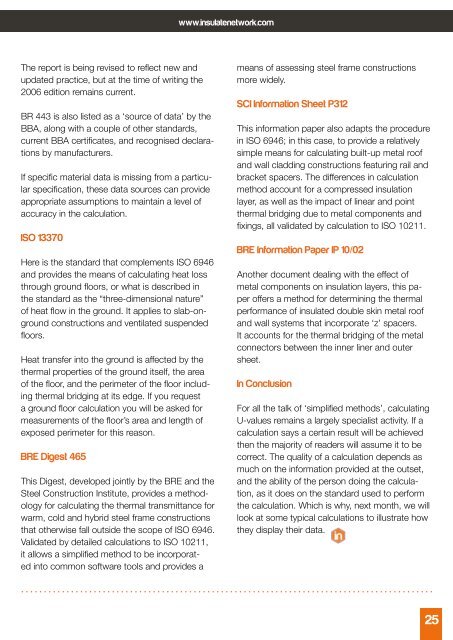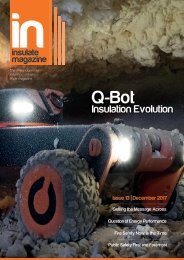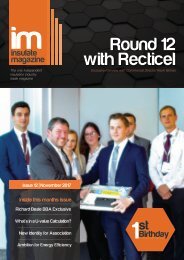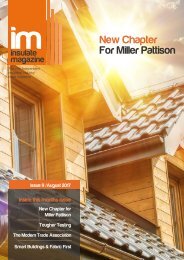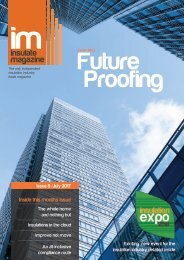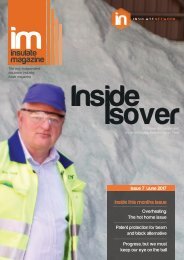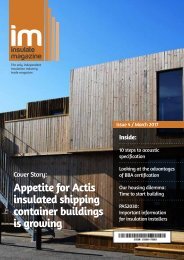Insulate Magazine Issue 11
Create successful ePaper yourself
Turn your PDF publications into a flip-book with our unique Google optimized e-Paper software.
www.insulatenetwork.com<br />
The report is being revised to reflect new and<br />
updated practice, but at the time of writing the<br />
2006 edition remains current.<br />
BR 443 is also listed as a ‘source of data’ by the<br />
BBA, along with a couple of other standards,<br />
current BBA certificates, and recognised declarations<br />
by manufacturers.<br />
If specific material data is missing from a particular<br />
specification, these data sources can provide<br />
appropriate assumptions to maintain a level of<br />
accuracy in the calculation.<br />
ISO 13370<br />
Here is the standard that complements ISO 6946<br />
and provides the means of calculating heat loss<br />
through ground floors, or what is described in<br />
the standard as the “three-dimensional nature”<br />
of heat flow in the ground. It applies to slab-onground<br />
constructions and ventilated suspended<br />
floors.<br />
Heat transfer into the ground is affected by the<br />
thermal properties of the ground itself, the area<br />
of the floor, and the perimeter of the floor including<br />
thermal bridging at its edge. If you request<br />
a ground floor calculation you will be asked for<br />
measurements of the floor’s area and length of<br />
exposed perimeter for this reason.<br />
BRE Digest 465<br />
This Digest, developed jointly by the BRE and the<br />
Steel Construction Institute, provides a methodology<br />
for calculating the thermal transmittance for<br />
warm, cold and hybrid steel frame constructions<br />
that otherwise fall outside the scope of ISO 6946.<br />
Validated by detailed calculations to ISO 102<strong>11</strong>,<br />
it allows a simplified method to be incorporated<br />
into common software tools and provides a<br />
means of assessing steel frame constructions<br />
more widely.<br />
SCI Information Sheet P312<br />
This information paper also adapts the procedure<br />
in ISO 6946; in this case, to provide a relatively<br />
simple means for calculating built-up metal roof<br />
and wall cladding constructions featuring rail and<br />
bracket spacers. The differences in calculation<br />
method account for a compressed insulation<br />
layer, as well as the impact of linear and point<br />
thermal bridging due to metal components and<br />
fixings, all validated by calculation to ISO 102<strong>11</strong>.<br />
BRE Information Paper IP 10/02<br />
Another document dealing with the effect of<br />
metal components on insulation layers, this paper<br />
offers a method for determining the thermal<br />
performance of insulated double skin metal roof<br />
and wall systems that incorporate ‘z’ spacers.<br />
It accounts for the thermal bridging of the metal<br />
connectors between the inner liner and outer<br />
sheet.<br />
In Conclusion<br />
For all the talk of ‘simplified methods’, calculating<br />
U-values remains a largely specialist activity. If a<br />
calculation says a certain result will be achieved<br />
then the majority of readers will assume it to be<br />
correct. The quality of a calculation depends as<br />
much on the information provided at the outset,<br />
and the ability of the person doing the calculation,<br />
as it does on the standard used to perform<br />
the calculation. Which is why, next month, we will<br />
look at some typical calculations to illustrate how<br />
they display their data.<br />
25


